| Article ID | Journal | Published Year | Pages | File Type |
|---|---|---|---|---|
| 10871784 | FEBS Letters | 2011 | 11 Pages |
Abstract
Although experimental autoimmune encephalomyelitis (EAE) is limited in its potency to reproduce the entirety of clinical and histopathologic features of multiple sclerosis (MS), this model has been successfully used to prove that MS like autoimmunity in the CNS is orchestrated by autoantigen specific T cells. EAE was also very useful to refute the idea that IFN-γ producing T helper type 1 (Th1) cells were the sole players within the pathogenic T cell response. Rather, “new” T cell lineages such as IL-17 producing Th17 cells or IL-9 producing Th9 cells have been first discovered in the context of EAE. Here, we will summarize new concepts of early and late T cell plasticity and the cytokine network that shapes T helper cell responses and lesion development in CNS specific autoimmunity.
Related Topics
Life Sciences
Agricultural and Biological Sciences
Plant Science
Authors
Franziska Petermann, Thomas Korn,
